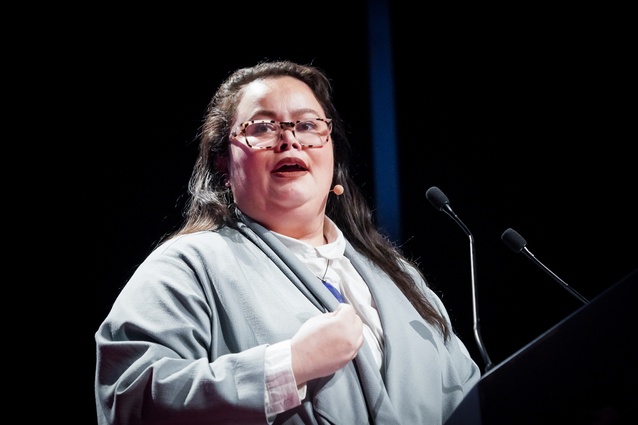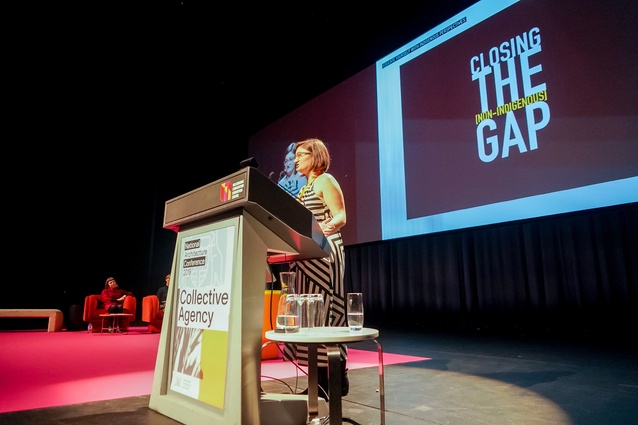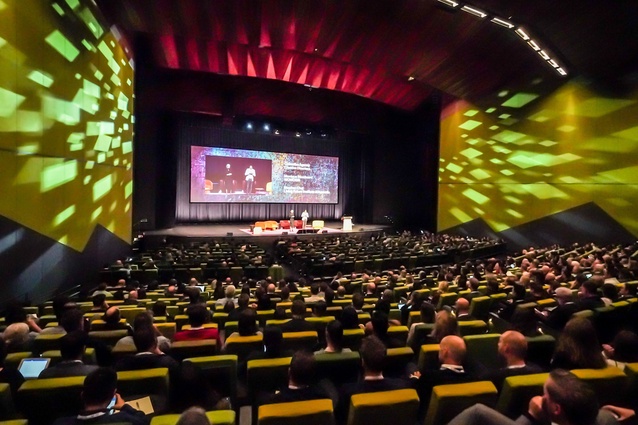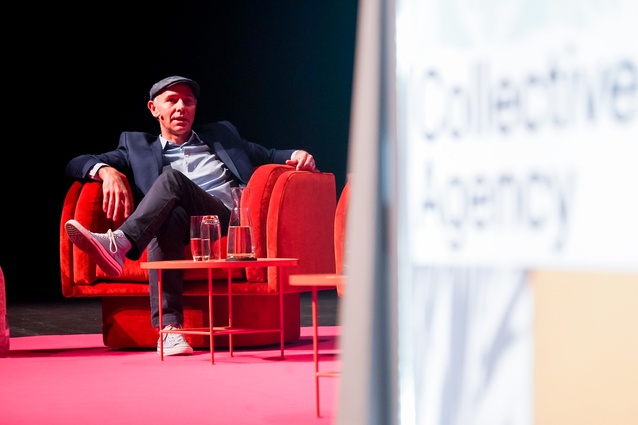The architect/the advocate: The role of advocacy and influence in architecture and design
Kiwi correspondent Haley Hooper and French transplant to Melbourne Camille Filippi report from the Australian Institute of Architects National Conference. They explore how architects and designers can act as advocates for the greater good here in Aotearoa and beyond.
Architects are also advocates. Architecture is a social and civic discipline, and in our current time the importance of the ‘design voice’ in development couldn’t be more critical. The lines between civic and social responsibility blur with those of a service and market driven industry. Yet, we understand the power of ‘the voice’ in architecture and the changes we can levy, propose and argue.
The people in our industry that speak, challenge and share important messages on behalf of many have a very prominent role to play in the effects of this influence: for developers, for governments and policy makers and for our public. It may be a service industry, but it’s a service industry unto what?
Camille Filippi attended the Australian Institute of Architects National Conference in Melbourne from 20 to 22 June 2019. The conference centred around the theme of Collective Agency, curated by Monique Woodward and Stephen Choi. It united a thought-provoking group of speakers from various backgrounds who challenged our conventions of architectural space and beyond. The conference looked to coalesce many issues, not always comfortably, but genuinely, towards collective purposes.
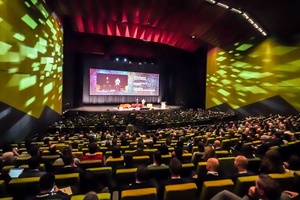
This year’s event was a departure from architecture and ‘the building’ (noun), towards architecture and the building (transitive verb). How are we building our communities, how could we be building our communities and what aren’t we doing so well?
There is a global impulse in people to actively agitate redundant political, social and environmental models. Global warming, fast-growing populations and cities, the effects of colonisation and journeys of decolonisation and the disappearance of habitats and species, among other problems, are expressly urging us to act.
By shaking norms and discussing the weaknesses and redundancies of established patriarchies, architects can foster government policies, plans and reforms that are more relevant and attentive to the societies and communities they endeavor to serve. This dialogue of action starts with an idea, is communicated through advocacy and is enacted by the willingness of many to pick up the challenge as, and when, it is laid down.
Collective Agency brilliantly demonstrated that architecture today shapes the world around us and has a very deciding human impact on it, as well as the environmental and economic impact. It appears that the role of an architect has morphed into a vast sense of responsibilities, towards a social and moral positioning that lends itself to activism.
Architecture can dismantle dogmas and infuse measurable and real societal changes. It is crucial: this call and need for the architect who is also advocate, agitator and disruptor. We must remember that ‘activism’ is ‘to act’. And that, as its definitions suggests, it “consists of efforts to promote, impede, direct, or intervene in social, political, economic, or environmental reform with the desire to make changes in society”.
In a service industry often deplored with diplomacies, controls and allegiances, we must still draw the lines towards argument and, hence, betterment. To have an opposing view, to reason, and to share, to discuss and then to find new understandings is to request change. We must request change not for conflict, but in order to cross necessary boundaries, reaching and extending ourselves and our communities towards new paradigms of living and being.
As one of the great Māori leaders of New Zealand, Sir James Henare of Ngati Hine, once said, “Kua tawhiti kē to haerenga mai, kia kore e haere tonu. He nui rawa o mahi, kia kore e mahi tonu. You have come too far, not to go further. You have done too much, not to do more.”

At the conference, there were a number of architects who spoke directly to this theme, demonstrating how they have taken on the role of influence, applied it to a need and found the reasons and ways to go further – using architecture as a vehicle and a voice for the community and the social system.
Sarah Lynn Rees, a Palawa (aborigonal Tasmanian) architect from Jackson Clements Burrows, eloquently demonstrated what new protocols should incorporate from a practice perspective: for example; an understanding and knowledge of the local culture, which goes in hand when designing within the country and its lands. She described it as being “embedded in country”, designing with respect for people, place and community.
Jeremy McLeod from Breathe Architecture is known for his strong advocacy and commitment to society, thanks to the well-acclaimed Nightingale Housing model, which places the community’s needs in the architectural and development spotlight. His priority is to rally solutions that are viable financially, socially and environmentally.
McLeod showed poise while explaining that revitalising voisinage can undo and repair the social divide and aspects of isolation while providing exemplars to inspire the industry to do better. He cleverly challenged what it means to be an architect in the 21st century. He then relayed ten ideas that Breathe Architecture successfully developed across their various projects, including The Queen Victoria Market new location project, Nightingale Housing and The Commons among others.
“Our choice as architects is option A: do nothing, do the work your client asks you to do; or option B: do something. We think our role is to advocate for those that perhaps don’t have a voice,” he says.
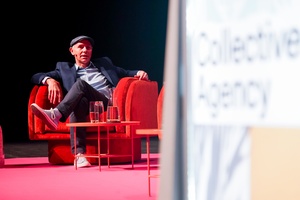
There is a marked difference between the 20th century architect and the 21st century architect. McLeod saw “cities designed by traffic engineers and lawyers, cities designed by spreadsheets, by people with money, to make money for people with money, locking-out entire generations”. So, he created a voice, a method and, now, a paradigm in Nightingale Housing that is successional and influencing and is still profitable, but not solely in dollar terms.
Elisapeta Heta from Jasmax in Aotearoa, New Zealand commenced like no other: in waiata, in song, incandescently and emotionally awakening the audience in voice. Her performance was exceptional and moving. The crystalline nature of her voice was reinforced by the crystalline nurture of her words. It was structured, strong and with an unbreakable bond. She said, “This was a song that is sung in lament but also in empowerment.” A neighbouring of words that speaks of the depth of feeling with which it was expressed.
“This was an ode to uplift the future generations of indigenous women. This is a song that I was taught that acknowledges the female atua that have been erased from the memory of my people because of colonisation,” she explained.
Courage, creativity and acknowledgment represent some of the most powerful tools to transform the usual trajectories of architecture and work. Elisapeta confidently took the auditorium right into the heart of New Zealand’s indigenous design community and revealed some of the many layers of how things are emerging and developing in Māori design and architectural practice.
She discussed meaningful projects and practices that have been embedded into architecture to lift indigenous ways of working and help them to thrive rather than just survive, making this a responsibility of all. She talked about the why in what she does through her collective identity, asking the question, “If not me, then who? How many more generations have to suffer after me?”
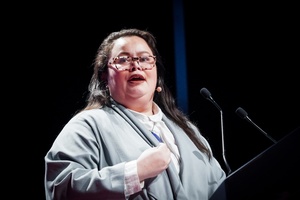
Historical and cultural narratives and principles are beginning to be more widely incorporated into design, creating an architecture and practice that doesn’t only embrace beautiful and functional design but also acknowledges indigenous people, acknowledges the past and elevates the present for a better future. Through her work and vision with Waka Māia at Jasmax, Elisapeta emphasises the need for recognising indigenous nations and their significance and explores how to help them to coexist through and into the spheres of architecture.
“We want to change the conversation from being one of obligation to being one of opportunity.” Elisapeta has a huge generosity in everything she does, she sees advocacy as the collective voice she is able to give: a form of reciprocity.
As a great advocate does, Elisapeta encourages us “to get comfortable with being uncomfortable. To get comfortable with multiple worldviews coexisting at the same time.” Perhaps no easy task, but a necessary one.
From your own interiority, from the seat of your affections, is it a place of patience, is it a place of tolerance? Where do you sit? But more importantly, where do you stand? What do you say? And then, what do you do?
The memorandum of understanding signed between the New Zealand Institute of Architects and Māori in New Zealand (2017), Te Kawenata o Rata, describes a place to start: an architecture of respect, authority and responsibility, knowledge and tikanga, cooperation and representation.
As we have heard before, small steps and little bits go a long way. Something is better than nothing, but perhaps the minimum is not quite good enough either. There is a role for advocacy in design. Architecture is a patterned language; it’s political; it’s directly associated to power, and it can have significant influence. We cannot think for the present only. Architects have the ability to turn ideas into real societal changes with measurable positive generational impacts.
As Elisapeta Heta said, “They are me, and I am them.” To manawa, e hine – with heart, girl.


